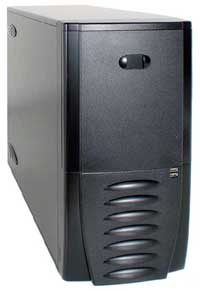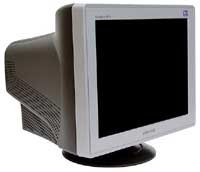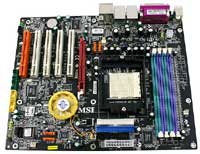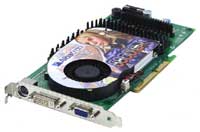AMD Mid-Range Gaming System
If you want some more
oomph in your system - say you like higher resolutions and antialiasing, or maybe you're a competitive online gamer - you could upgrade a few parts in the Budget System and end up with acceptable performance. We're going to kick it up another notch for the Mid-Range segment by improving nearly every component.
| Mid-Range AMD Athlon 64 System |
| Hardware |
Recommended Component |
Price |
| Processor |
AMD Athlon 64 3500+ 512K 2.2 GHz (939) 90nm |
285 |
| Motherboard |
MSI K8N Neo2 Platinum |
131 |
| Memory |
Mushkin Dual Pack 2x512 PC3200 2.5-3-3 |
159 |
| Video Card |
Albatron GeFORCE 6800 GT 256MB GDDR3 |
374 |
| Hard Drive |
Seagate 160GB SATA 7200RPM 8MB Model ST3160023AS |
93 |
| Optical Drive |
NEC DVD+/-RW Drive Model 3500A |
72 |
| Case and Power Supply |
Antec SLK3700-BQE with 350W |
91 |
| Display |
Samsung SyncMaster 997DF 19 CRT |
234 |
| Speakers |
Logitech Z-640 5.1 |
52 |
| Keyboard |
Logitech Internet Keyboard |
17 |
| Mouse |
Microsoft IntelliMouse Optical |
24 |
| Bottom Line |
|
1532 |

Click to enlarge. |
We return to several components that we have recommended in the past for the Mid-Range system. We've doubled the amount of RAM, and we've upgraded the case and PSU to the Antec SLK3700-BQE. It's not a flashy case, so if you're interested in that, you might look elsewhere. Nevertheless, it is a well thought out design, and the use of dual 120mm fans provides ample cooling when you add in the front fan. For the monitor, we have upgraded to a 19" CRT, which has the ability to run at 1600x1200 with a 75 Hz refresh rate. The NEC FE991SB is also an option, although it costs $40 more. We have upgraded to a Serial ATA hard drive with 160GB storage capacity, again staying with Seagate and their five-year warranty. Most of the other base components remain the same, although we opted for the five-button Microsoft IntelliMouse Optical this time.

Click to enlarge. |
The major changes come in the selection of motherboard, CPU, and graphics card. This should come as no surprise, as we have already mentioned several times that these are the most important aspects of a gaming system. For the processor, we have upgraded to an Athlon 64 3500+. The raw clockspeed advantage is not that great, but our
initial tests of the 90nm parts show a slight performance increase relative to the older 130nm 3500+, particularly in games, and it also has better overclocking capabilities if you're interested in that. The power use of the 90 nm parts is also substantially lower than the 130 nm design. The total price increase is $20 relative to the 130nm part, so either one is fine. The motherboard that we have selected uses the NForce3 250 Ultra chipset, and it was also our Gold Editor's Choice in our
Socket 939 Motherboard Roundup. There are several socket 939 motherboards with similar features that use the VIA K8T800 Pro chipset, but we have stuck with the NVIDIA chipset as tests have shown that it has a slight performance advantage when used with an NVIDIA graphics card compared to boards using the VIA chipset. ATI boards do not incur any penalties either, should you choose to go that route. If you prefer the VIA based boards, the Abit AV8 and Asus A8V both received our Silver Editor's Choice.

Click to enlarge. |
Speaking of graphics, our recommendation goes to a GeForce 6800GT AGP model. With 16 pixel pipelines, a 350 MHz GPU core and 1 GHz GDDR3 RAM, it provides nearly twice the performance of the 9800 Pro and significantly more than the 6600GT as well. Performance doesn't vary much if at all between the various manufacturers, so we have selected the card that we could find for the lowest price. You could also look into spending a bit more for a BFG 6800GT OC model that comes factory overclocked or the Leadtek model with it's larger two-slot HSF, but otherwise there is not a whole lot to differentiate among the designs. For ATI lovers, the X800 Pro actually offers very similar performance to the 6800GT. It only has 12 pixel pipelines, but since they're clocked at 475 MHz instead of 350 MHz, it ends up as almost a tie. The 6800GT has faster RAM - 1 GHz compared to 900 MHz - and it also includes Shader Model 3.0 support, not to mention a lower price. If you can find the X800 Pro for less than the 6800GT, though, it's definitely worth considering.

Click to enlarge. |
Then again, the AGP socket could become something of a limitation for upgrades by that time. We have recently previewed the
NForce 4 chipset as well as
ATI's RX480. Both should be available for purchase before the end of the year, and the NVIDIA boards will likely start showing up by the end of this month. If you're considering a socket 939 platform, and assuming you're willing to pay the price premium, it could be worth waiting for the PCI Express motherboards to ship. We'll take a look at PCI Express costs with our Intel Mid-Range alternative. SLI is also a very attractive feature for those looking to buy one card now and upgrade later. All told, an SLI-capable system will probably cost about $100 more than an equivalent AGP setup, but with AGP you're stuck with one graphics card.














70 Comments
View All Comments
benk - Monday, November 22, 2004 - link
The Dell 2001FP is listed at 799 and is often on sale for well below 700.Swaid - Monday, November 22, 2004 - link
Illissius -I was just about to suggest that. The Epox motherboard is a much better "buy" then the Chaintech now.
Illissius - Monday, November 22, 2004 - link
I agree with nearly all the choices, which can't be said for most other buying guides I've read :)My one suggestion is that the EPoX 8KDA3J costs nearly the same as the Chaintech VNF3-250, and has more functionality -- namely, it uses the 250Gb chipset.
kherman - Monday, November 22, 2004 - link
AGP:Anyone wondering aobut when it will be phased out, just look back to old PCI video cards. Took about 1-2 years for manufacturers to drop AGP support altogether. It's a supply demand issue.
As for mobo's I'd expect to see new mobo's w/AGP for atleast a year more. Some people iwll be using those older video cards after all. Also, multiple PCI-X slots are the goal and if I understand correctly, PCI altogether will be dropped, menaing network and sound cards will also need a PCI-X home.
Anyways...my 2 cents.
kherman - Monday, November 22, 2004 - link
How about RAID 5 for the "fully employed" system? Would be redundant and should give slightly faster load times ;)kherman - Monday, November 22, 2004 - link
"Budget Gaming System, Part Two"IMHO: Keep the 2800+ part and spend that extra $50 on a better video card. That will give better frame rates, IMO of course.
JarredWalton - Monday, November 22, 2004 - link
I've heard conflicting reports about the quality of gaming on the Dell 2001FP. Some people love it, and others think it's good but perhaps not great. The price on it is also subject to quite a bit of variation. Right now, I believe it's on sale for about the same as the Viewsonic, while "normally" it might be $1000 plus shipping. I have not actually used one in person, so I can't really comment on interpolation quality, but of the LCDs that I have used, I have yet to see one that offers interpolation of such a quality that I wouldn't hesitate to recommend it. Opinions on that, of course, differ.The same goes for the wireless mouse. Some people swear by the MX510. I've tried it, and I simply did not like it. The Microsoft wireless mice I've tried were even worse, however. Anyway, the choice of mouse is very personal. I really like the standard MS Optical five button. It's light and accurate enough that I don't have any complaints. Even with an unlimited budget, I would still buy that same mouse for my own use. I *could* go out and try numerous other mice, but I'm just not that concerned with that one peripheral. If you are, more power to you! :)
MiLLeRBoY - Monday, November 22, 2004 - link
Also, for the High-End Gaming, check out the new the Logitech Z-5500 Digital speakers. It's just a revamped version of the Z-680's design as well as adding more power. The subwoofer is noticeably larger than the former though. The retail price is $400.MiLLeRBoY - Monday, November 22, 2004 - link
DEMO24 - I have the 20.1" Dell 2001FP and it only has a 16ms response time. However, I don't see ghosting when playing games. I also play my games at 1024x768 with 4xAA when the LCD's native resolution is 1600x1200. The image interpolation is great, it doesn't look horrible even at 1280x1024 or 1024x768. And the price is around the same as the ViewSonic VP912B. However, I probably wouldn't mind using any of those two LCDs, they're both great.xsilver - Monday, November 22, 2004 - link
?? min 18A on 12v rail -- crap my PSU doesn't have that... will it not run a AMDs939? (15A -- enhance brand, respectable, heavy)